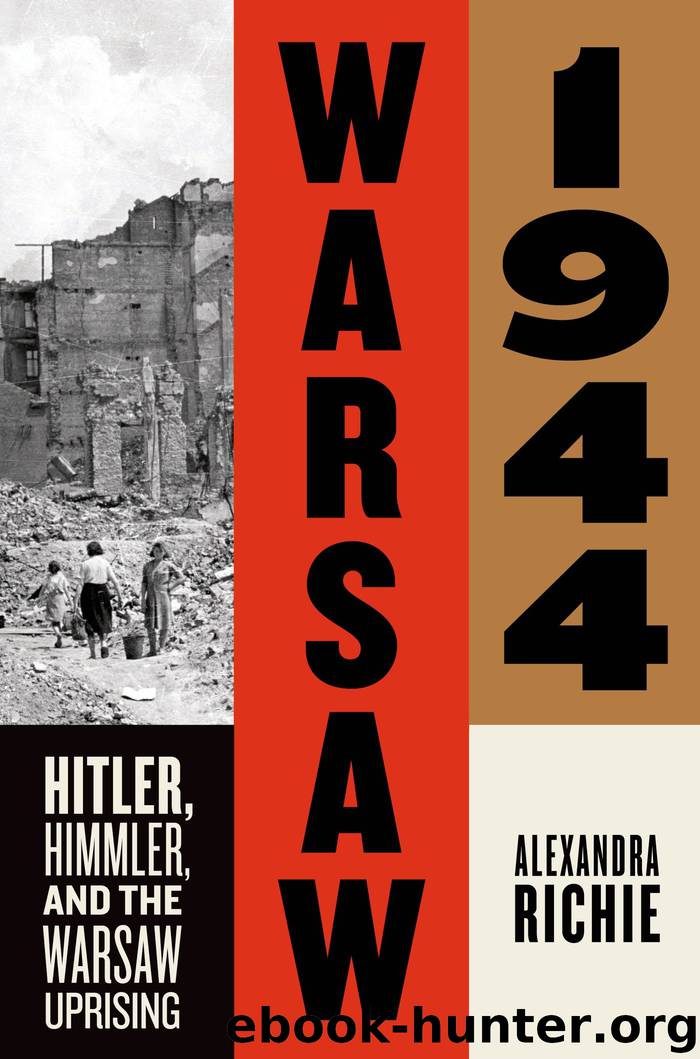Warsaw 1944: Hitler, Himmler, and the Warsaw Uprising by Richie Alexandra

Author:Richie, Alexandra [Richie, Alexandra]
Language: eng
Format: epub
Publisher: Farrar, Straus and Giroux
Published: 2015-10-09T16:00:00+00:00
10
HITLER’S WAR AGAINST THE OLD TOWN
They had neither allies, nor mercenaries, nor supplies for enduring a siege, nor anything else in readiness for this sudden and unheralded war, while by themselves they could not prevail against the Romans and Masinnissa combined. (Chapter X)
The Fortress
When Bernardo Bellotto first arrived in Warsaw in 1764 as King Stanisław August Poniatowski’s new Court Painter, he was deeply moved by the beauty of the Old Town. This jewel in the crown of Warsaw, one of the gems of Europe, stood high above the Vistula, its dramatic skyline of towers, spires and domes spilling down towards the river below. Bellotto set about documenting the city as his uncle Canaletto had Venice, creating an extraordinary series of paintings which now hang, as was intended, in the Warsaw Castle. In these masterpieces the city is rendered in soft greens and golds and pinks, preserving in great detail the beauty of its graceful churches and tall, colourful houses and exquisite palaces nestled together in the busy and bustling capital. The paintings would prove invaluable in the reconstruction of Warsaw’s Old Town after 1945, because by then everything that Bellotto had known had been destroyed.
With Wola now taken, the Germans turned towards the river, and focused on the Old Town. This area was important because of its proximity to the Vistula, and above all because of the Kierbedź Bridge, which was vital for the supply of the troops in Praga and beyond. The Old Town had to be defeated, and fast.1 Reinefarth was not daunted. Wola had fallen relatively quickly, and he had no reason to think that the small district by the Vistula would be any different. But he was wrong.
The fiercest fighting around the Old Town in the first weeks of August 1944 took place in an area measuring ten square kilometres, and shaped rather like half an onion, with the Vistula at its base and concentric rings running around the tiny medieval core. The outermost layer consisted of the no man’s land bordered by the Traugutta Fort and the Gdańsk railway station to the north, the former ghetto to the west, and Senatorska Street and the ruins of the Warsaw Castle to the south.
The next layers were made up of imposing swathes of grand eighteenth- and nineteenth-century buildings put up after the ‘Swedish Deluge’ had destroyed so much of the city in the 1650s. Famous architects had been called in from all over Europe, and the great white columns and grand façades were testimony to their skill. The pediment reliefs and statues on the glorious Krasiński Palace, one of the most beautiful Baroque buildings in the city, were carved by the great Prussian sculptor Andreas Schlüter, who created the famous Amber Room in Peter the Great’s palace in St Petersburg, and whose works graced the most prestigious buildings in Berlin. The Nazis renamed Krasiński Square in his honour, although that did not stop them from pulverizing the palace in 1944. There were exquisite structures at every turn
Download
Warsaw 1944: Hitler, Himmler, and the Warsaw Uprising by Richie Alexandra.epub
This site does not store any files on its server. We only index and link to content provided by other sites. Please contact the content providers to delete copyright contents if any and email us, we'll remove relevant links or contents immediately.
| Belgium | France |
| Germany | Great Britain |
| Greenland | Italy |
| Netherlands | Romania |
| Scandinavia |
Room 212 by Kate Stewart(4123)
The Crown by Robert Lacey(4122)
Endurance: Shackleton's Incredible Voyage by Alfred Lansing(3859)
The Iron Duke by The Iron Duke(3657)
The Rape of Nanking by Iris Chang(3531)
Killing England by Bill O'Reilly(3469)
Joan of Arc by Mary Gordon(3272)
Say Nothing by Patrick Radden Keefe(3078)
I'll Give You the Sun by Jandy Nelson(2850)
Shadow of Night by Deborah Harkness(2748)
Hitler's Monsters by Eric Kurlander(2741)
Margaret Thatcher: The Autobiography by Thatcher Margaret(2692)
Mary, Queen of Scots, and the Murder of Lord Darnley by Alison Weir(2683)
Darkest Hour by Anthony McCarten(2655)
Blood and Sand by Alex Von Tunzelmann(2616)
Red Famine: Stalin's War on Ukraine by Anne Applebaum(2473)
Eleanor & Park by Rainbow Rowell(2402)
The One Memory of Flora Banks by Emily Barr(2357)
Book of Life by Deborah Harkness(2286)
